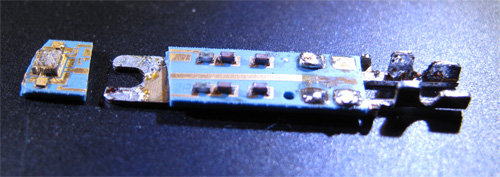The Ware for December 2009 is the active element of a Tektronix P7350 5GHz Differential probe, photos courtesy of tmbinc. It’s a $7,000 oscilloscope probe, and the technology inside of it is exquisite. From the high frequency ceramic substrate to the wirebonded decoupling capacitors, no expense was spared in making the probe. I can only speculate what kind of technology is used for the IC in the center of the photo; it looks like it has gold metallization, which is unusual to see on any silicon process since gold contamination causes a deep-level trap defect in silicon. That leads me to think maybe it’s a III-V (i.e., GaAs or InP) process where gold is more common. On the other hand, Brian points out that the backside is biased, which isn’t something you’d require if the devices were fabbed using the common semi-insulating substrate technique employed on many III-V designs.

Above: an image of almost the entire probe circuit. There’s another fragment that would be to the left that is also missing. I feel compelled to note that tmbinc (the photographer for this ware) didn’t break the probe; he bought it broken for cheap.
I’ve been a long time fan of Tek products; their engineers are hard-core and I typically learn something new every time I take the hood off of one of their devices. Back when digital scopes came into being, Tek made the only respectable digital scope (in my opinion) because they understood that the integrating behavior of phosphors in analog scopes was actually a desirable effect, a feature so important that they gave it a name: Digital Phosphor Technology. The other thing Tek did really Right was to keep all the old analog-ish knobs on their panels. Back in the analog days you had all sorts of trim, sweep, scale, trigger, etc. knobs that were a direct part of the oscilloscope’s analog circuitry. Of course, when we transitioned into the digital world, there was no more essential requirement for all these knobs. Agilent went so far as to create digital oscilloscopes (like the 54120) with a single jog dial that was modal. Everytime you wanted to switch from adjusting the timebase or amplitude scales, you had to reprogram the knob’s mode by hitting a couple buttons. It was a terrible UI that really killed productivity, but I imagine some product manager at Agilent must have thought he or she was really clever for optimizing the complex and expensive analog oscilloscope UI down to a single knob. The Tek digital scopes, on the other hand, had a bank of buttons almost exactly like they had on their analog scopes, so the tool had a great hand feel to it.
Anyways, back to the competition. The winner is Brian! Very impressive deduction skills, I was thinking this might have been a real stumper (I know I wouldn’t have guessed it), but again I was proven wrong. Email me to claim your prize!
Yeah, he had a solid analysis, and guessed it right, too!
I totally agree about the knobs and ease of use. When I was designing software to operate a USB oscilloscope, I chose Tektronix layouts to lift ideas from.
tmbinc gave me the chip at 26c3 for imaging. I’ll post the link soon :)
A quick note on the possible die technology.
[ a longer post with links seems to have vanished into
WordPress moderation ]
If you head to the Tek website, go to About Us->Press Releases,
search terms ‘probe’ and ‘Sige’, a number of hits come up.
Many of the press releases for close relatives of the
P7350 mention SiGe technology (although the P7350 release
itself does not)
Of particular note is the March 29, 2004 release mentioning
the P7380SMA probe:
”
” Tektronix plans to deliver a new member of the P7300
” differential active probe family mid-2004 using the
” same 7HP SiGe ASIC that supports the full bandwidth
” of the oscilloscope and features convenient attachment
” to the device under test for multiple use cases.
”
It sounds like they designed a common ASIC to use in
different variants of the probe family, at least for
some of the probes in that series.
Brian
[…] it. So what I did was to go to eBay, and buy a broken P7350, in the hope I could repair it. Well, it didn’t work. The probe was already foobar when I got it, but I’ve learned important things about probes: […]
Even worse than modal UI’s, I’ve used scopes that clearly booted Windows.
Here are the images:
http://www.dropbox.com/gallery/4064278/2/ICs/Tektronix%20P7350?h=c6de56